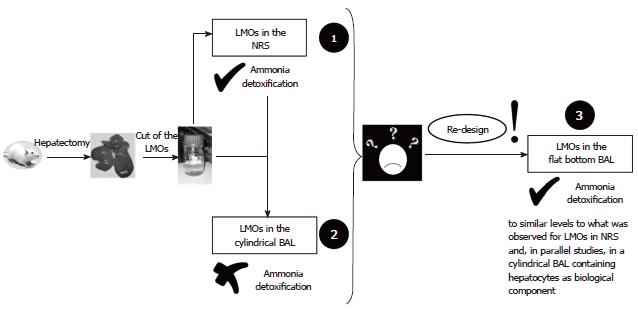Copyright
©The Author(s) 2018.
World J Hepatol. Oct 27, 2018; 10(10): 719-730
Published online Oct 27, 2018. doi: 10.4254/wjh.v10.i10.719
Published online Oct 27, 2018. doi: 10.4254/wjh.v10.i10.719
Figure 1 Schematic representation of the steps followed to arrive to the design of a “flat -bottom” bio-artificial liver device suitable to support the appropriate performance of liver microorgans as the biological component.
Liver microorgans (LMOs) were obtained from Wistar rat livers: (1) Evaluation of LMO performance parameters in Normothermic Reoxygenation System; (2) Evaluation of LMO performance in cylindrical bio-artificial liver (BAL) and finding that they were unable to detoxify an ammonia overload in the test blood; (3) Evaluation of LMO performance in the newly designed “flat -bottom” BAL that proved suitable to support ammonia detoxification function. LMO: Liver microorgan; NRS: Normothermic Reoxygenation System; BAL: Bio-artificial liver.
Figure 2 Devices used to analyze liver microorgan performance.
A: Liver microorgan (LMO) disposition in the Normothermic Reoxygenation System (NRS).; B: Cylindrical shaped bio-artificial liver (BAL).; C: “Flat bottom” shaped BAL.; D: Perfusion system components. BC: Biological compartment; Lp: LMO loading port; Ap 1 and 2: Biological compartment access ports; Bsp: Blood sampling port; O2/CO2: Carbogen supply; Ox: Silicone oxygenating tube.
- Citation: Pizarro MD, Mamprin ME, Daurelio LD, Rodriguez JV, Mediavilla MG. Experimental bio-artificial liver: Importance of the architectural design on ammonia detoxification performance. World J Hepatol 2018; 10(10): 719-730
- URL: https://www.wjgnet.com/1948-5182/full/v10/i10/719.htm
- DOI: https://dx.doi.org/10.4254/wjh.v10.i10.719










